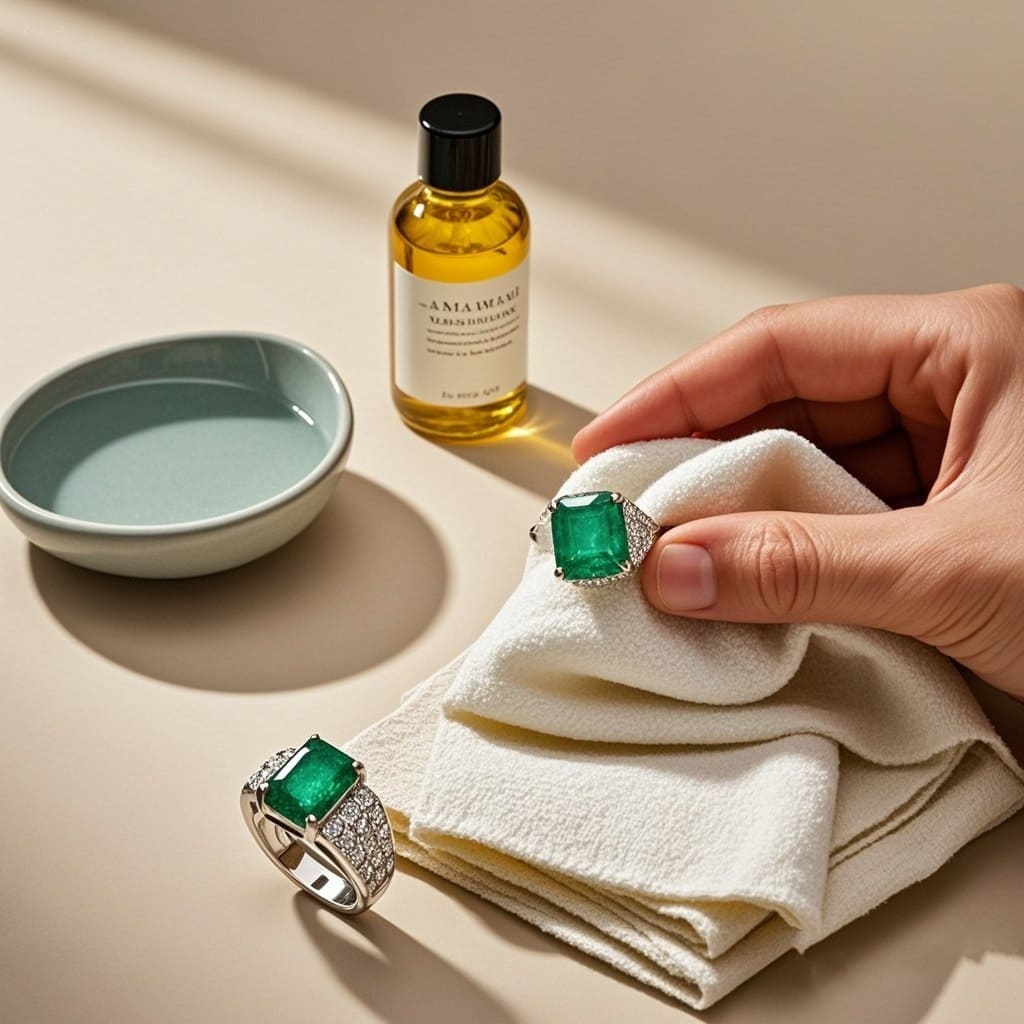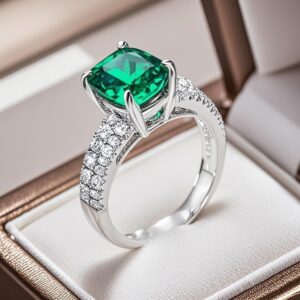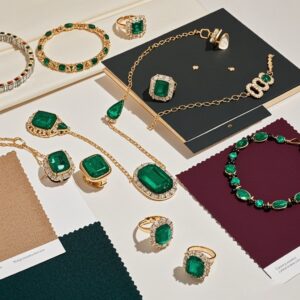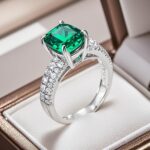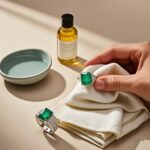Emeralds are among the most captivating gemstones on Earth, loved for their rich green hues and luxurious feel. Whether you’ve just received a stunning emerald ring or inherited a treasured piece from your family, one question inevitably arises:
“Can you put emeralds in jewelry cleaner?”
It’s a fair question—after all, commercial jewelry cleaners are marketed as quick, effective solutions. But when it comes to emeralds, the answer is far more complex.
Emeralds are unique not just in appearance but in composition and treatment. Their natural formation results in internal fractures and inclusions that make them especially vulnerable to damage if improperly cared for. Many emeralds are treated with oils to enhance their clarity—treatments that commercial cleaners can easily strip away.
In this guide, we’ll explain why emeralds require special care, how improper cleaning can destroy them, and most importantly, how to clean emerald jewelry safely at home or with professional help. By the end, you’ll know exactly what to avoid and how to keep your emeralds gleaming for years to come..jpg)
一. Why You Shouldn’t Put Emeralds in Jewelry Cleaner
It’s tempting to drop your emerald ring into a commercial jewelry cleaner—after all, it works wonders on diamonds and gold. But with emeralds, this can be a costly mistake.
1.Emeralds Are Treated with Oil
Most natural emeralds contain visible internal fractures—what gemologists call “jardin” or “gardens.” To enhance clarity and durability, these fissures are often filled with natural oils or resins.
Jewelry cleaners can dissolve or strip these oils, leaving your emerald looking dull, dry, or even cracked.
2. Harsh Chemicals Can Corrode the Gemstone
Commercial jewelry cleaners may contain ammonia, alcohol, or acids, which can corrode the emerald or weaken its internal structure. Over time, these chemicals degrade the clarity and stability of the stone, particularly in untreated or lightly oiled gems.
3. Ultrasonic and Steam Cleaners Are Too Aggressive
Ultrasonic cleaners use high-frequency sound waves to agitate cleaning fluid, while steam cleaners blast the jewelry with high-pressure steam.
Both are dangerous for emeralds.
They can:
- Widen existing fractures
- Dislodge filler oils
- Loosen prongs or bezels
- Cause irreversible internal or surface damage
4. Once Damaged, Restoration Is Costly
Once the oil is stripped or a crack appears, restoring an emerald is not simple. Re-oiling must be done by a professional using the right materials under careful conditions. In some cases, damage can be permanent.
Bottom line: Putting emeralds in jewelry cleaner can do more harm than good. The risk of dulling, cracking, or completely ruining your emerald is very real.
.jpg)
二. Understanding the Nature of Emerald Jewelry
Before diving into how to clean emerald jewelry, it’s crucial to understand what makes emeralds so unique—and so delicate.
1. Emeralds Have Natural Inclusions
Unlike diamonds, which can be nearly flawless, emeralds almost always have internal inclusions. These are part of their beauty and authenticity. However, they make the gemstone more brittle, especially when exposed to pressure or heat.
2.Mohs Hardness Is Only Part of the Story
Emeralds rank 7.5 to 8 on the Mohs hardness scale, which might seem fairly durable. But this measures scratch resistance—not structural integrity.
Emeralds are tough in terms of surface but fragile due to their internal structure.
3.Common Treatments You Need to Know
Most emeralds on the market have been:
- Oiled: With cedarwood or other natural oils to enhance clarity.
- Resin-treated: Sometimes polymers are used, which are more stable but less natural.
Understanding these treatments is critical. They affect how you clean, wear, and store your jewelry.
4.Why Extra Care Is Essential
If you’re committed to maintaining natural emerald jewelry, you’ll need to go beyond general jewelry care tips. That means:
- No abrasive cloths
- No harsh chemicals
- Gentle cleaning only
- Regular re-oiling (optional but helpful for older pieces)
Emeralds aren’t fragile to the point of being unwearable—but they do require knowledge and respect.
.jpg)
三. How to Clean Emerald Jewelry
Now that we’ve covered why harsh cleaning methods are a no-go for emeralds, let’s focus on what actually works. Whether your emerald ring has lost its sparkle or your necklace has gathered dust, the right cleaning routine will keep it beautiful and safe for years to come.
1.Gentle At-Home Cleaning: Step-by-Step
Cleaning your emerald jewelry at home is possible—as long as you do it carefully. Here’s a trusted method that protects the gem’s oil treatment and avoids internal damage:
You’ll Need:
- A small bowl of lukewarm water
- A few drops of mild liquid soap (like dish soap or baby shampoo)
- A soft microfiber cloth
- A very soft-bristled brush (like a baby toothbrush)
- A clean, dry towel
Steps:
1.Prepare the solution
Fill a bowl with lukewarm water and add a drop or two of mild soap. Stir gently to create a soapy solution.
- Soak the jewelry briefly
Place your emerald jewelry in the bowl and let it soak for no more than 1 minute. Unlike diamonds, emeralds should never be left in water for extended periods.
- Gently brush
Use a soft toothbrush to clean around the setting and gently sweep over the gemstone.
Be careful not to press too hard—especially around any inclusions or fractures.
- Rinse quickly
Rinse under lukewarm running water to remove any soap. Do this quickly, and avoid sudden temperature changes.
- Dry and polish
Pat dry with a soft microfiber cloth and let it air-dry completely. Avoid using paper towels or tissues, as they can scratch the surface.
Pro Tip: Avoid submerging emeralds with open-back settings. Instead, dip the brush into the soapy water and clean directly.
2. Professional Cleaning: When and Why
While you can handle basic maintenance at home, professional help is sometimes the safest choice. You should take your emerald jewelry to a professional jeweler once a year if you wear it often.
Here’s what they can offer that DIY methods cannot:
- Thorough but safe cleaning using industry-grade soft solutions
- Re-oiling treatments to restore clarity and luster
- Inspection of prongs and settings to ensure your gemstone is secure
Never let a jeweler use an ultrasonic or steam cleaner on emeralds, even if they recommend it. A certified gemologist will know this rule well.
3. What NOT to Do When Cleaning Emerald Jewelry
Even well-intentioned care can damage emeralds. Avoid these common mistakes at all costs:
| ❌ Don’t | Why |
| Use ultrasonic or steam cleaners | Can cause internal fractures and remove oil treatment |
| Use alcohol, acetone, or vinegar | These chemicals dry out the stone and degrade clarity |
| Use toothpaste or baking soda | Abrasive materials scratch the gemstone and metal |
| Soak for too long | Extended water exposure can affect oils and loosen settings |
| Use hot or cold water | Sudden temperature changes may cause cracking |
If you’re unsure about any product or method, don’t risk it. Emeralds are too valuable and delicate to experiment with.
4. How Often Should You Clean Emerald Jewelry?
The frequency depends on how often you wear the piece and how exposed it is to dirt, oil, and sweat.
- Daily wear (e.g., rings): Clean every 2–4 weeks
- Occasional wear (e.g., earrings, pendants): Clean every 1–2 months
- Before special events: Light cleaning the day before enhances shine
Regular but gentle care not only keeps your emerald looking brilliant but also helps preserve its structure and treatment.
.jpg) 7
7
四. Safe Alternatives to Jewelry Cleaner
When it comes to emerald jewelry, the safest cleaning methods are often the simplest. While store-bought jewelry cleaners may be marketed as effective for all gemstones, they are almost never safe for emeralds. These commercial solutions often contain ammonia, alcohol, or acidic ingredients that can strip away the gem’s protective oil treatment or worsen internal fractures.
So what can you use instead? Below are safe, effective alternatives to traditional jewelry cleaners, ideal for emerald jewelry owners.
1. Lukewarm Soapy Water: The Gold Standard
This method was already outlined in Section 3, but it’s worth emphasizing again. A few drops of mild dish soap in lukewarm water is not only the safest method—it’s also the most accessible.
Why it works:
- No harsh chemicals
- Gentle on both the gemstone and the metal setting
- Easy to control the temperature and application
This method is ideal for routine cleanings every few weeks.
2. Natural Solutions: When to Use and When to Avoid
You may come across DIY cleaning suggestions involving natural ingredients like vinegar, lemon juice, or baking soda. These may work for other gemstones or metals, but they are too acidic or abrasive for emeralds.
Let’s clarify what is and is not safe:
Safe:
- Distilled water with mild soap
- A soft-bristled brush
- A microfiber or cotton cloth
Not Safe:
- Vinegar
- Baking soda
- Lemon juice
- Alcohol-based cleaners
These natural ingredients can etch the surface of the emerald, affect the oil layer, or weaken the integrity of the setting.
3. Jewelry Cleaning Wipes: A Cautious Option
Some companies now sell jewelry cleaning wipes labeled as gentle or safe for all gemstones. If you choose to try these, read the ingredients carefully. Look for alcohol-free, ammonia-free, and acid-free formulas.
These wipes can be useful in situations where water cleaning is not practical—such as during travel—but they should only be used occasionally and very gently.
Still, nothing beats a soft cloth and a little soap and water for everyday maintenance.
4. Professional Ultrasonic or Steam Cleaning: Always a No
Although we covered this in earlier sections, it bears repeating here. Emeralds should never be placed in an ultrasonic cleaner or cleaned with steam, regardless of what the label or salesperson says.
Emeralds often contain natural fissures that are filled with oil to improve clarity. High-pressure or high-heat cleaning can:
- Expose those fractures
- Dry out the oils
- Cause cracks to worsen or multiply
- Damage the setting
Even if your emerald looks solid to the naked eye, internal flaws may react unpredictably under stress.
When in doubt, skip commercial devices altogether and stick with the basics.
5. What About Jewelry Cleaner Labeled Safe for Emeralds
You may find niche products that claim to be emerald-safe. Some may be legitimate, but most rely on diluted formulas or lack industry-standard testing.
Before using:
Research the brand and product
Check the ingredients list
Look for reviews from gemologists or jewelers
When possible, consult with your jeweler first
If you cannot confirm its safety through reliable sources, do not use it.
6. When to Clean and When to Wait
Sometimes the safest choice is not to clean at all, especially if:
The stone appears loose in the setting
You notice cloudiness or strange streaks under the surface
The emerald looks dull despite cleaning
These signs may indicate internal fractures or drying oil treatments. In such cases, the best course of action is to take your jewelry to a qualified jeweler or gemologist for evaluation and possibly re-oiling.
.jpg)
五. Daily Wear and Storage Tips for Emerald Jewelry
Even if you clean your emerald jewelry properly, improper wear and storage can still lead to damage. Emeralds, while beautiful, are naturally more fragile than diamonds or sapphires. They are prone to chipping, cracking, and drying out if not treated with care.
This section offers practical, easy-to-follow tips to protect your investment for years to come.
1. Wearing Emerald Jewelry: What You Need to Know
Avoid Wearing Emeralds During High-Impact Activities
Emeralds are not ideal for everyday rough wear. Whether you are doing housework, gardening, or exercising, it is best to take your jewelry off. Even minor bumps can cause damage to the stone or loosen the setting.
Avoid activities like:
- Sports
- Cooking (especially with oils and spices)
- Cleaning (contact with chemicals or surfaces)
- Showering or swimming
Apply Cosmetics Before Putting on Jewelry
Perfumes, lotions, hairsprays, and makeup can all interact negatively with emeralds or their settings. Always finish your skincare and beauty routine before wearing your jewelry. This prevents product buildup that can cloud or damage the stone over time.
Check for Loose Settings Regularly
Emeralds are often set in prongs or bezels that can become loose over time. Before putting on your ring, earrings, or pendant, give it a gentle wiggle. If you feel any movement, take it to a jeweler before wearing it again.
Signs of a loose setting:
- Stone shifts when touched
- You hear a clicking sound
- Gaps appear between the stone and setting
2. Storing Emerald Jewelry Properly
How and where you store your emerald jewelry matters just as much as how you clean or wear it.
Keep Pieces Separated
Never store emeralds with other jewelry, especially diamonds or harder gemstones. Emeralds can be scratched, and they can also scratch softer stones.
Best practice:
Store each piece in a separate soft pouch or a fabric-lined compartment of a jewelry box.
Avoid Direct Sunlight and Heat
Prolonged exposure to sunlight or high temperatures can dry out the oils used to treat the emerald, making it appear cloudy or increasing the risk of internal cracks.
Do not store:
- Near windows
- In a hot car
- Close to heaters or appliances
Maintain Moderate Humidity
Unlike many other gemstones, emeralds benefit from a slightly humid environment, especially if they’ve been treated with oil. If stored in an overly dry place, the oil can evaporate, making flaws more visible.
Storage tip:
Place a small damp cloth (not touching the jewelry) in the storage box to gently maintain humidity, especially in dry climates.
Use Anti-Tarnish Strips for Metal Settings
If your emerald is set in silver or other tarnish-prone metals, adding anti-tarnish strips can help keep the entire piece looking fresh. These strips are safe for emeralds as long as they do not come in direct contact with the stone.
3. Seasonal and Occasional Wear Considerations
Emeralds are often worn during special occasions, weddings, or holidays. While it is safe to wear them occasionally, you should avoid dramatic temperature changes and environments with smoke, chemicals, or intense lighting.
Examples of times to take extra caution:
- Winter holidays (rapid changes between cold outdoors and heated interiors)
- Summer events (exposure to sun, sweat, and heat)
- Kitchens or dining events (risk of splatter or chemical exposure)
Let Your Jewels Rest
Finally, like fine leather or silk, emerald jewelry benefits from rest. If you own multiple pieces, rotate their use rather than wearing one item constantly. This minimizes wear and gives the gemstone time to recover from exposure to light, air, and body oils.
Conclusion
Emerald jewelry is a timeless treasure that requires special care to maintain its natural beauty and durability. Due to its unique fragility and the presence of natural inclusions, emeralds need gentle cleaning, careful handling, and proper storage to stay radiant for years to come.
In this article, we covered safe cleaning methods that avoid harsh chemicals and ultrasonic cleaners, the importance of regular inspections and oil treatments, and practical tips for daily wear and storing your emerald pieces. By following these guidelines, you can protect your emerald jewelry from damage and preserve its stunning color and brilliance.
Remember, emeralds are more than just decorative stones—they are precious natural gifts and meaningful symbols. With thoughtful maintenance and attention, your emerald jewelry can remain a cherished part of your collection and a beautiful companion through life’s moments.
